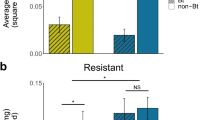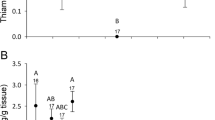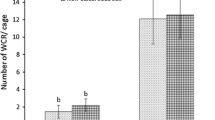Abstract
Traditionally, control of European corn borer (Ostrinia nubilalis) Hübner has been achieved through the use of chemical insecticides. With increasing emphasis on reducing pesticide inputs in agricultural production, alternative management technologies are now being used including transgenic silage corn modified to express Cry1Ab protein toxins derived from Bacillus thuringiensis (Bt) Berliner. The Cry1Ab toxin is expressed by all plant cells and throughout the growing season. Furthermore, the toxins are exuded from corn plant roots into the rhizosphere, raising concerns over possible side-effects on non-target beneficial organisms in the same habitat. In addition, detrivores are exposed to crop residues containing the toxin when incorporated into the soil. The current 2-year study (2003, 2004) evaluated effects of two silage-corn varieties: Pioneer var. 38A25 (Bt-corn expressing the Cry1Ab toxin) and Pioneer var. 38A24 (parent isoline) on species diversity and evenness of carabid beetles and Collembola. Pitfall traps were used to collect surface-dwelling species on a bimonthly schedule from April to October. Soil cores were taken once a month from April to October to sample subterranean species, which were extracted using Berlese funnels. All individuals were recorded and identified where possible to species level for analysis in the Simpson’s D and Shannon–Wiener H’ diversity indices. Evenness was measured using Simpson’s E’, after which dominant species were analyzed in a multivariate ordination analysis. Results showed Bt-corn had no negative effects on any of the organisms analyzed. There was a significant year effect on the abundance of surface-dwelling Collembola and on species diversity of soil-dwelling Collembola. Our findings suggest that crop management practices and/or environmental conditions (e.g., heavy rainfall during the 2004 growing season) had the greatest impact on species diversity and evenness, rather than the crop itself (Bt or isoline).




Similar content being viewed by others
References
Al-Deeb MA, Wilde GE, Blair JM et al (2003) Effect of Bt corn for corn rootworm control on nontarget soil microarthropods and nematodes. Environ Entomol 32:859–865
Baumgarte S, Tebbe CC (2005) Field studies on the environmental fate of the Cry1Ab Bt-toxin produced by transgenic maize (MON810) and its effect on bacterial communities in the maize rhizosphere. Mol Ecol 14:2539–2551. doi:10.1111/j.1365-294X.2005.02592.x
Baute TS, Sears MK, Schaafsma AW (2002) Use of transgenic Bacillus thuringiensis Berliner corn hybrids to determine the direct economic impact of the European corn borer (Lepidoptera: Crambidae) on field corn in Eastern Canada. J Econ Entomol 95:57–64
Berg MP, Stoffer M, van der Heuvel HH (2004) Feeding guilds in Collembola based on digestive enzymes. Pedobiologia (Jena) 48:589–601. doi:10.1016/j.pedobi.2004.07.006
Bhatti MA, Duan J, Head G et al (2005) Field evaluation of the impact of corn rootworm (Coleoptera: Chrysomelidae) protected Bt corn on ground-dwelling invertebrates. Environ Entomol 34:1325–1335. doi:10.1603/0046-225X(2005)034[1325:FEOTIO]2.0.CO;2
Bitzer RJ, Rice ME, Pilcher CD et al (2005) Biodiversity and community structure of epedaphic and eudaphic springtails (Collembola) in transgenic rootworm Bt corn. Environ Entomol 34:1346–1376. doi:10.1603/0046-225X(2005)034[1346:BACSOE]2.0.CO;2
Bohac J (1999) Staphylinid beetles as bioindicators. Agric Ecosyst Environ 74:357–372. doi:10.1016/S0167-8809(99)00043-2
Booth RG, Anderson JM (1979) The influence of fungal food quality on the growth and fecundity of Folsomia candida (Collembola: Isotomidae). Oecologia 38:317–323. doi:10.1007/BF00345191
Christiansen K, Bellinger P (1998) The Collembola of North America. Part 1:2. Grinell College, Iowa
Clark BW, Coats JR (2006) Subacute effects of Cry 1Ab Bt corn litter on the earthworm Eisenia fetida and the springtail Folsomia candida. Environ Entomol 35:1121–1129. doi:10.1603/0046-225X(2006)35[1304:GBCCAI]2.0.CO;2
Cortet J, Griffiths BS, Bohanec M et al (2007) Evaluation of effects of transgenic Bt maize on microarthropods in a European multi-site experiment. Pedobiologia (Jena) 51:207–218. doi:10.1016/j.pedobi.2007.04.001
Daly T, Buntin D (2005) Effect of Bacillus thuringiensis transgenic corn for lepidopteran control on nontarget arthropods. Environ Entomol 34:1292–1301. doi:10.1603/0046-225X(2005)034[1292:EOBTTC]2.0.CO;2
de Vaufleury A, Kramarz PE, Binet P et al (2007) Exposure and effects assessments of Bt-maize on non-target organisms (gastropods, microarthropods, mycorrhizal fungi) in microcosms. Pedobiologia (Jena) 51:185–194. doi:10.1016/j.pedobi.2007.04.005
Dively GP, Rose R (2003) Effects of Bt transgenic and conventional insecticide control on the non-target natural enemy community in sweet corn. In: Proceedings, 1st international symposium on biological control of arthropods, Jan 14–18, 2002, Honolulu, Hawaii, USA, pp 265–274
Downie NM, Arnett RH Jr (1996) Beetles Northeastern N Am I:II. Sandhill Crane Press, Gainsville
Dutton A, Klein H, Romeis J et al (2002) Uptake of Bt-toxin by herbivores feeding on transgenic maize and consequences for the predator Chrysoperla carnea. Ecol Entomol 27:441–447
Flores S, Saxena D, Stotzky G (2005) Transgenic Bt plants decompose less in soil than non-Bt plants. Soil Biol Biochem 37:1073–1082
Greenslade P, Vaughan GT (2003) A comparison of Collembola species for toxicity testing of Australian soils. Pedobiologia 47:171–179
Griffiths BS, Caul S, Thompson J et al (2005) A comparison of soil microbial community structure, protozoa, and nematodes in field plots of conventional and genetically modified maize expressing the Bacillus thuringiensis Cry 1Ab toxin. Plant Soil 275:135–146
Griffiths BS, Caul S, Thompson J et al (2006) Soil microbial and faunal community responses to Bt maize and insecticides in two soils. J Environ Qual 35:734–741
Haughton AJ, Champion GT, Hawes C et al (2003) Invertebrate responses to the management of genetically modified herbicide-tolerant and conventional spring crops II. Within-field epigeal and aerial arthropods. Philos Trans R Soc London 358:1863–1877
Hietala-Koivu R, Järvenpää T, Helenius J (2004) Value of semi-natural area as biodiversity indicators in agricultural landscapes. Agric Ecosyst Environ 101:9–19
Hyde J, Martin MA, Preckel PV et al (1999) The economics of Bt corn: valuing protection from the European corn borer. Rev Agric Econ 21:442–454
Icoz I, Stotzky G (2008) Fate and effects of insect-resistant Bt-crops in soil ecosystems. Soil Biol Biochem 40:559–586
Iperti G (1999) Biodiversity of predaceous Coccinellidae in relation to bioindication and economic importance. Agric Ecosyst Environ 74:323–342
Jasinski JR, Eisley JB, Young CE et al (2003) Select nontarget arthropod abundances in transgenic and nontransgenic field crops in Ohio. Environ Entomol 32:407–413
Kaneda S, Kaneko N (2004a) The feeding preference of a collembolan (Folsomia candida Willem) on ectomycorrhiza (Pisolithus tinctorius (Pers.)) varies with mycelial growth condition and vitality. Appl Soil Ecol 27:1–5
Kaneda S, Kaneko N (2004b) Growth of the collembolan Folsomia candida Willem in soil supplemented with glucose. Pedobiologia 48:165–170
Kromp B (1999) Carabid beetles in sustainable agriculture: a review on pest control efficacy, cultivation impacts and enhancement. Agric Ecosyst Environ 74:187–228
Larochelle A (1976) Manuel d’identification des carabidae du Quebec. Cordulia, Suppl 1
Lawo NC, Romeis J (2008) Assessing the utilization of a carbohydrate food source and the impact of insecticidal proteins on larvae of the green lacewing, Chrysoperla carnea. Biol Control 44:389–398
Llewellyn D, Cousings Y, Mathews A et al (1994) Expression of Bacillus thuringiensis insecticidal protein genes in transgenic crop plants. Agric Ecosyst Environ 49:85–93
Lopez MD, Prasifka JR, Bruck DJ et al (2005) Utility of ground beetle species in field tests of potential nontarget effects of Bt crops. Environ Entomol 34:1317–1324
Lundgren JG, Wiedenmann RN (2005) Tritrophic interactions among Bt (Cry3Bb1) corn, aphid prey, and the predator Coleomegilla maculata (Coleoptera: Coccinellidae). Environ Entomol 34:1621–1625
Lundgren JG, Shaw JT, Zaborski ER et al (2006) The influence of organic transition systems on beneficial ground-dwelling arthropods and predation of insects and weed seeds. Renew Agric Food Syst 21:227–237
Magurran AE (2004) Measuring biological diversity. Blackwell, Massachusetts
Marasas WFO, Nelson PE, Toussoun TA (1984) Toxigenic Fusarium species. Pennsylvania State University Press, London
Meier MS, Hilbeck A (2001) Influence of transgenic Bacillus thuringiensis corn-fed prey on prey preference of immature Chrysoperla carnea (Neuroptera: Chrysopidae). Basic Appl Ecol 2:35–44
Muchaonyerwa P, Waladde S, Nyamugafata P et al (2004) Persistence and impact on microorganisms of Bacillus thuringiensis proteins in some Zimbabwean soils. Plant Soil 266:41–46
Natural Resources Conservation Service (NRCS) (2004) United States Department of Agriculture. http://www.vt.nrcs.usda.gov/. Cited 6 Jul 2006
Pilcher CD, Rice ME, Higgins RA et al (2002) Biotechnology and the European corn borer: measuring historical farmer perceptions and adoption of transgenic Bt corn as a pest management strategy. J Econ Entomol 95:878–892
Romeis J, Battini M, Bigler F (2003) Transgenic wheat with enhanced fungal resistance causes no effects on Folsomia candida (Collembola: Isotomidae). Pedobiologia 47:141–147
Romeis J, Dutton A, Bigler F (2004) Bacillus thuringiensis toxin (Cry1Ab) has no direct effect on larvae of the green lacewing Chrysoperla carnea (Stephens) (Neuroptera: Chrysopidae). J Insect Physiol 50:175–183
Roy DB, Bohan DA, Haughton AJ et al (2003) Invertebrates and vegetation of field margins adjacent to crops subject to contrasting herbicide regimes in the farm scale evaluations of genetically modified herbicide-tolerant crops. Philos Trans R Soc London 358:1879–1898
Sabatini MA, Innocenti G (2000a) Soil-borne plant pathogenic fungi in relation to some collembolan species under laboratory conditions. Mycol Res 104:1197–1201
Sabatini MA, Innocenti G (2000b) Functional relationships between Collembola and plant pathogenic fungi of agricultural soils. Pedobiologia 44:467–475
Sabatini MA, Ventura M, Innocenti G (2004) Do Collembola affect the competitive relationships among soil-borne plant pathogenic fungi? Pedobiologia 48:603–608
SAS Institute Inc (2004) Version 9.1.3. Help and documentation. SAS Institute Inc, Cary, NC
Saxena D, Stotzky G (2000) Insecticidal toxin from Bacillus thuringiensis is released from roots of transgenic Bt corn in vitro and in situ. FEMS Microbiol Ecol 33:35–39
Saxena D, Stotzky G (2001a) Bacillus thuringiensis (Bt) toxin released from root exudates and biomass of Bt corn has no apparent effect on earthworms, nematodes, protozoa, bacteria, and fungi in soil. Soil Biol Biochem 33:1225–1230
Saxena D, Stotzky G (2001b) Bt corn has a higher lignin content than non-Bt corn. Am J Bot 88:1704–1706
Saxena D, Flores S, Stotzky G (2002a) Vertical movement in soil of insecticidal CryIAb protein from Bacillus thuringiensis. Soil Biol Biochem 34:111–120
Saxena D, Flores S, Stotzky G (2002b) Bt toxin is released in root exudates from 12 transgenic corn hybrids representing three transformation events. Soil Biol Biochem 34:133–137
Saxena D, Stewart CN, Altosaar I et al (2004) Larvicidal Cry proteins from Bacillus thuringiensis are released in root exudates of transgenic B. thuringiensis corn, potato, and rice but not of B. thuringiensis canola, cotton, and tobacco. Plant Physiol Biochem 42:383–387
Sims SR, Martin JW (1997) Effect of Bacillus thuringiensis insecticidal proteins Cry1A(b), Cry1A(c), CryIIA, and Cry IIIA on Folsomia candida and Xenylla grisea (Insecta: Collembola). Pedobiologia 41:412–416
Spahr VHJ, Abbildung M (1981) The importance of Collembola for soil biology and their suitability as test organisms for ecotoxicology. Anz Für Schädlingskunde 54:27–29
Stork NE, Eggleton P (1992) Invertebrates as determinants and indicators of soil quality. Am J Alt Agricult 7:38–47
Stotzky G (2004) Persistence and biological activity in soil of the insecticidal proteins from Bacillus thuringiensis, especially from transgenic plants. Plant Soil 266:77–89
Swift MJ, Heal OW, Anderson JM (1979) Decomposition in terrestrial ecosystems. Blackwell, Oxford
Ter Braak CJF, Smilauer P (2002) CANOCO reference manual and CanoDraw for Windows user’s guide: software for canonical community ordination (version 4.5). Microcomputer Power, New York
Thimm T, Hoffmann A, Borkott H et al (1998) The gut of the soil microarthropod Folsomia candida (Collembola) is a frequently changeable but selective habitat and a vector for microorganisms. Appl Environ Microbiol 64:2660–2669
Van den Brink PJ, Ter Braak CJF (1998) Multivariate analysis of stress in experimental ecosystems by principle response curves and similarity analysis. Aquatic Ecol 32:163–178
VanDyk J (1996) How corn is damaged by the European corn borer. http://www.ent.iastate.edu/pest/cornborer/howdamage/damage1.html. Cited 21 Oct 2005
Wiggins EA, Curl EA, Harper JD (1979) Effects of soil fertility and cotton rhizosphere on populations of Collembola. Pedobiologia 19:75–82
Wiles JA, Frampton GK (1996) A field bioassay approach to assess the toxicity of insecticide residues on soil to Collembola. Pestic Sci 47:273–285
Witkowski J, Wright R (1997) The European corn borer: biology and management. http://entomology.unl.edu/ecb/ecb1.htm. Cited 11 Jul 2005
Witkowski JF, Wedberg JL, Steffey KL et al (2002) University of Minnesota Extension Service: Bt corn & European corn borer, long-term success through resistance management. http://www.extension.umn.edu/distribution/cropsystems/DC7055.html. Cited 11 Jul 2005
Wolfenbarger LL, Naranjo SE, Lundgren JG et al (2008) Bt crop effects on functional guilds of non-target arthropods: a meta-analysis. PLoS ONE 3:e2118. doi:10.1371/journal.pone.0002118
Wright RJ, Hunt TE, Witkowski JF et al (2000) Nebraska cooperative extension NF00-409: choosing a Bt transgenic corn hybrid. http://ianrpubs.unl.edu/fieldcrops/nf409.htm. Cited 21 Oct 2005
Yu L, Berry RE, Croft BA (1997) Effects of Bacillus thuringiensis toxins in transgenic cotton and potato on Folsomia candida (Collembola: Isotomidae) and Oppia nitens (Acari: Orbatidae). J Econ Entomol 90:113–118
Acknowledgments
This manuscript is published as a requirement for the degree of Master of Science at the University of Vermont. Research was supported by Vermont Agricultural Experiment Station Hatch Project no. VT-PS-00921, and the S-301 Regional Hatch Project “Development, Evaluation and Safety of Entomopathogens for Control of Arthropod Pests.”
Author information
Authors and Affiliations
Corresponding author
Rights and permissions
About this article
Cite this article
Priestley, A.L., Brownbridge, M. Field trials to evaluate effects of Bt-transgenic silage corn expressing the Cry1Ab insecticidal toxin on non-target soil arthropods in northern New England, USA. Transgenic Res 18, 425–443 (2009). https://doi.org/10.1007/s11248-008-9234-z
Received:
Accepted:
Published:
Issue Date:
DOI: https://doi.org/10.1007/s11248-008-9234-z




